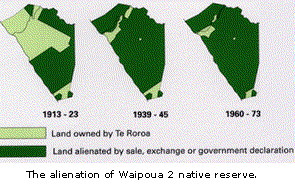Case study: Waipoua native reserve
Waipoua 2 (also known as the Waipoua native reserve) was the block of land which the two chiefs Tiopira and Parore had agreed would be Tiopira's tribal reserve. Including the kauri forest, it covered 12,220 acres. Because the land had been registered with the Native Land Court, it was no longer an area under tribal control and could be surveyed into separate little parcels, each with an individual 'owner'. This made it easier for the Crown to buy it.

In July 1917, the Government said that, if the owners of the Waipoua native reserve wanted to sell their land, they could sell it only to the Government. Over the next few years, the Crown bought much of the land bit by bit. While many of the Māori owners were overseas fighting in the First World War, Crown agents gained agreements to sell from the people left at home. When the owners returned home from the war, they found that their land had been sold.
By 1923, the Crown had purchased over 6113 acres. The Government decided what the price for the land was, in some cases based on outdated land values. The value of the native timber on the land was not included in the price, and neither were any buildings. The Government logged the timber, replanted much of the land in pine forest or sold the land for farming, and made a large profit.
Between 1939 and 1945, a further 4734 acres were purchased by the Crown. This was at a time when most of the Te Roroa men were fighting overseas in the Second World War. Te Roroa also gave the Crown some land for a school to be established at Waipoua.
In 1972, the Government said that the land could again be sold to anyone. Between 1960 and 1973, the Crown had acquired nearly another 450 acres. Of the 12,220 acres originally set aside as a reserve, only 690 acres remained Maori land. And all of that was in multiple ownership rather than a tribal reserve as Tiopira had wanted.
Next: Life in Today's World
This page was last updated: